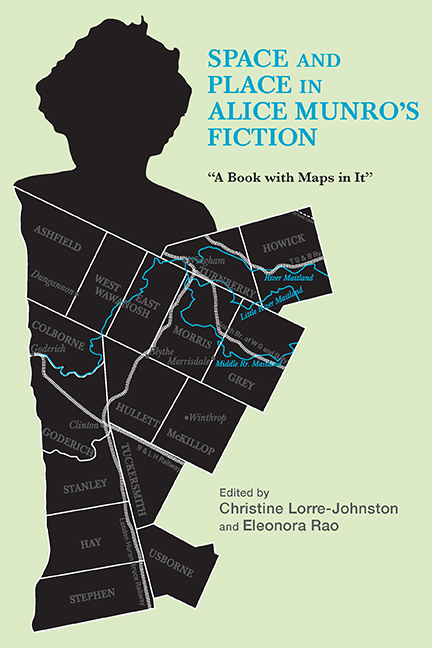Book contents
- Frontmatter
- Contents
- List of Illustrations
- Acknowledgments
- List of Abbreviations
- Introduction
- Part I Conceptualizing Space and Place: Houses, Landscapes, Territory
- 1 Where Do You Think You Are? Alice Munro's Open Houses
- 2 “Whose House Is That?” Spaces of Metamorphosis in Alice Munro's Dance of the Happy Shades, Who Do You Think You Are?, and The View from Castle Rock
- 3 Mapping the Vernacular Landscape in Alice Munro's “What Do You Want to Know For?” and Other Stories
- 4 Stories in the Landscape Mode: A Reading of Alice Munro's “Lives of Girls and Women,” “Walker Brothers Cowboy,” and “Lichen”
- 5 “What Place Is This?” Alice Munro's Fictional Places and Her Place in Fiction
- 6 “The Emptiness in Place of Her”: Space, Absence, and Memory in Alice Munro's Dear Life
- 7 Down the Rabbit Hole: Revisiting the Topos of the Cave in Alice Munro's Short Stories
- Part II Close Readings of Space and Place
- Bibliography
- Notes on the Contributors
- Index
4 - Stories in the Landscape Mode: A Reading of Alice Munro's “Lives of Girls and Women,” “Walker Brothers Cowboy,” and “Lichen”
from Part I - Conceptualizing Space and Place: Houses, Landscapes, Territory
Published online by Cambridge University Press: 15 August 2018
- Frontmatter
- Contents
- List of Illustrations
- Acknowledgments
- List of Abbreviations
- Introduction
- Part I Conceptualizing Space and Place: Houses, Landscapes, Territory
- 1 Where Do You Think You Are? Alice Munro's Open Houses
- 2 “Whose House Is That?” Spaces of Metamorphosis in Alice Munro's Dance of the Happy Shades, Who Do You Think You Are?, and The View from Castle Rock
- 3 Mapping the Vernacular Landscape in Alice Munro's “What Do You Want to Know For?” and Other Stories
- 4 Stories in the Landscape Mode: A Reading of Alice Munro's “Lives of Girls and Women,” “Walker Brothers Cowboy,” and “Lichen”
- 5 “What Place Is This?” Alice Munro's Fictional Places and Her Place in Fiction
- 6 “The Emptiness in Place of Her”: Space, Absence, and Memory in Alice Munro's Dear Life
- 7 Down the Rabbit Hole: Revisiting the Topos of the Cave in Alice Munro's Short Stories
- Part II Close Readings of Space and Place
- Bibliography
- Notes on the Contributors
- Index
Summary
IN A MUCH QUOTED ESSAY, Alice Munro resorts to an analogy to illustrate the importance of design in her short stories and the way she envisions the tension between spatial containment and temporal flow that is constitutive of the genre: “Everybody knows what a house does, how it encloses space and makes connections between one enclosed space and another and presents what is outside in a new way. This is the nearest I can come to explaining what a story does for me, and what I want my stories to do for other people.” The architectural parallel is perhaps less striking than the way Munro elaborates upon it to enhance what a story does rather than what it merely is. For Munro, a decisive effect is achieved when story material falls into place to produce a connection—“the queer bright moment” toward which all her stories tend. In some of them landscape plays an active role in the connection that causes the transmutation of motif into motive. The inclusion of landscape in the field of representation then effectively reconfigures the human actions taking place in the foreground in ways that recall how the genre surreptitiously entered Renaissance art through the window, the veduta, conveniently placed at the back of the painting. Such stories I propose to call stories in the landscape mode. In this chapter I will be looking at three of them—“Lives of Girls and Women,” “Walker Brothers Cowboy,” and “Lichen”—chosen because of their treatment of landscape. In each of them, landscape triggers moments of recognition when clarity of insight is mitigated with irony, grotesquerie, or even, sometimes, humiliation. All three play to various degrees with the conventions of the nude, complicit as they are with the aesthetic covenants governing the appreciation of landscape, to probe the political and poetic implications of the feminization of the land, which has been one of the constants of Canadian painting and literature since their inception.
In Land Sliding, W. H. New looks at two paintings that combine the conventions of landscape and those of the nude in striking ways.
- Type
- Chapter
- Information
- Space and Place in Alice Munro's Fiction“A Book with Maps in It”, pp. 82 - 99Publisher: Boydell & BrewerPrint publication year: 2018



